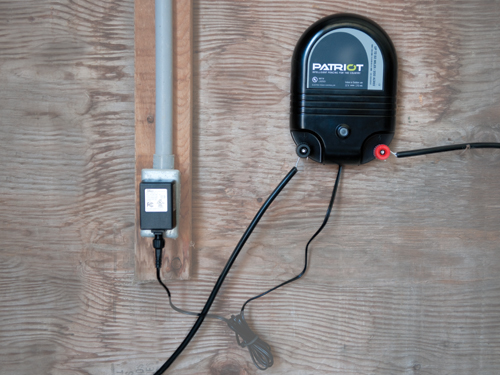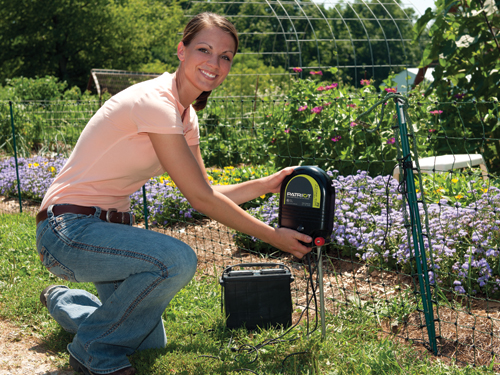1. Ant problems
Sprinkle the bottom of the energizer with ant dust (such as Terro). Do not sprinkle dust on the circuit board, because dust can retain moisture and damage/corrode the circuit board.
2. Testing an energizer
Disconnect the fence and ground rod wires from the energizer’s terminals. Use a fence tester to test charge. Touch the ground rod probe to the ground rod terminal of the tester. Touch the tester’s clip to the fence terminal. The following reading will tell you the status of your energizer
.
If the energizer is faulty and you’re using a 110-volt plug-in unit:
Check that the 110v outlet is “live” by using a plug-in drill or test light. If the test light works and the energizer does not, call Premier about repairs.
 Patriot units can also be used as a plug-in unit. Insert the AC adapter into the energizer to utilize its potential.
Patriot units can also be used as a plug-in unit. Insert the AC adapter into the energizer to utilize its potential.If the energizer is faulty and you are using a battery unit, you need to find out if the problem is with the battery or the energizer:
- If it’s a 12-volt energizer, carry the unit to a nearby vehicle and attach the input cords carefully to the vehicle’s battery.
- If the energizer now works, then your energizer’s battery needs to be recharged or replaced.
- If the energizer does not work, then you should call Premier about repairs.
Testing the Ground Rod:
-
- Set up the energizer and fence. To test the ground with a
- (a digital one works best), insert energizer’s ground probe into the soil and touch the fence tester to the ground rod. You will need more ground rod if the reading is more than 300 volts.
Fuse:
- If your energizer has a fuse and is not working, check the fuse to make sure it’s functioning. Replace the fuse if it’s broken.
3. How to store a solar energizer for the winter:
- Store the energizer at room temperature.
- Fully charge the battery prior to storage.
- Clear any dust/debris from the solar panel.
- Turn off the energizer by pressing the button on the side of the unit.
4. PRS unit tips for winter
-
- Winter will be arriving soon and that means that the main grazing season for most of us will be at an end. For those of us using
- , this means we’ll be putting them away for winter, and those lucky enough to keep using them will have to modify their usage.
If you’re not using your PRS unit during the winter, follow these tips to preserve battery life:
- Turn off the unit. Disconnecting the unit from the fence is not sufficient, because the unit will still pulse unless it’s turned off.
- Clean off the solar panel. Dust and debris may have accumulated during use, preventing the panel from maximum electrical production.
- Before the unit goes into storage, fully charge the unit. This will allow the battery to be topped off. Batteries that are charged 50% or less may become damaged in freezing temperatures.
- If possible, place the unit in a sunny area to allow the solar panel to continuously top-off the battery. The battery will lose charge over time even if the unit is disconnected from the fence and turned off.
By Sara McArtor, Premier Sales Consultant




